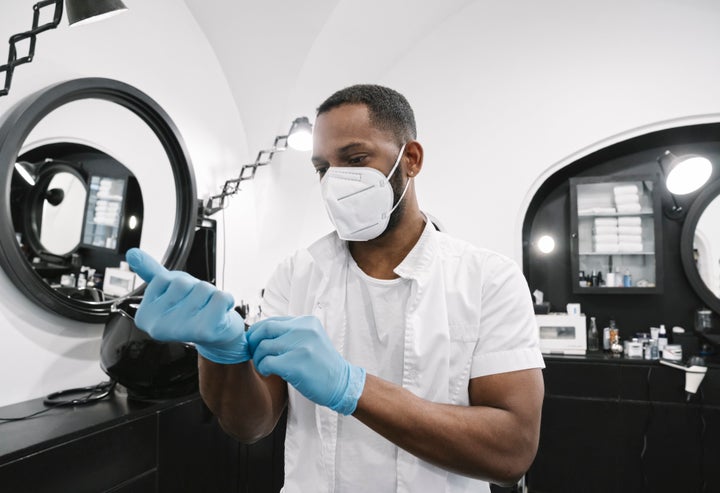Whether you’re as shaggy as Cousin It or currently avoiding Zoom meetings to hide a disastrous at-home trim, the COVID-19 pandemic has many of us fantasizing about frequenting hair salons once more. And manicure fanatics who have exhausted their colour collections are just as keen.
In many parts of the country that are entering new pandemic stages and allowing personal care services to start up again, Canadians can make their dreams come true and visit their favourite reopened beauty salon. But is that a good idea?
There is no such thing as a completely risk-free salon visit while viral cases are still active in your area, population health expert Anna Bershteyn told InStyle. But from a psychological standpoint, expecting all Canadians to stay inside as cases trend downward is a tall ask for those experiencing pandemic fatigue: An Angus Reid poll found that only 36 per cent of Canadians are steering clear of all public spaces, as the majority did in March. More than half of respondents said they are spending time outside, while continuing to practice social distancing.
For those set on making a hair or nail appointment at this time, there are ways to reduce the risk of transmission. Like grocery stores, many reopened salons are enforcing protective rules and changed their operations in order to keep customers safe. Here’s what you should do before booking with your favourite stylist or technician:
1. Read your area’s safety guidelines
Depending on what stage they’re in, rules for how businesses should be operating will differ depending on what their local and provincial health authority has deemed necessary.
The Eastern Ontario Health Unit, for example, has a checklist of required measures that salons should follow, which include screening staff for COVID-19 symptoms prior to their shifts, a ban on beard trimmings (as they involve mask removal), frequent hand washing, and using barriers or limiting people inside in order to keep distance in check.
Similar guidance exists in Alberta, which asks salons and barber shops to display government-sanctioned posters.
2. Check if masks are mandatory
Health Canada’s recommendations for workplaces are extensive, with many asking establishments to be as contact-less as possible and use face masks when staying two metres apart isn’t possible.
Given the close proximity for personal services, salons are likely to ask everyone who enters their establishments to wear masks. Any that aren’t enforcing mask usage may be putting anyone who enters at risk; two Kingston, Ont. nail salons closed down after 27 workers and customers contracted COVID-19. Inspectors found that masks weren’t worn at the salon with the most infections, CBC reports, along with inadequate distancing measures.

3. Figure out how long your appointment will take
Are you in for a quick touch-up or anticipating a full dye job? Depending on your beauty concerns, it might be best to consult with your provider before booking; lengthy trips may increase your risk and certain salons are implementing time limits on stays.
However, appointments that are too short can also be a problem, a cosmetic brands distributor warns. Jeff Alford, president of CBON Group, notes that if a product takes a certain amount of time to “set” and a service provider seems to be rushing, or if the business is serving high volumes of clients, that could be a red flag for the salon’s hygiene levels.
“If your salon or spa has fast client turnover that does not allow for proper sanitizing protocols to take place, you should be aware of the heightened exposure to infection you may be facing,” Alford said in a press release.
4. Verify your salon’s safety measures online or in-person
Given how each salon may implement pandemic protocol differently, it’s best to do some research on what local businesses are offering in terms of revamped rules.
Assistant manager Sugee Ce from Vancouver’s SoHo Nail Boutique said her salon has multiple posters and signs with safety information viewable in-person, as well as details on what customers can expect available online.

If your salon doesn’t have a social media presence, calling ahead of booking and confirming over the phone may be useful. Aside from asking about masks and going over what your province recommends, it may also be worth asking what gets disinfected, what products are one-time use only, and what the waiting room or line-up situation looks like.
5. Pee beforehand
Seriously. Given the lack of public toilets in most major Canadian cities, it’s a good idea to heed nature’s call before going for an appointment.
6. Do your part
As much as a salon can try to mitigate transmission, it’s also up to customers reduce the likelihood. Bring a mask (an extra, just in case yours gets soiled or malfunctions, would be smart), hand sanitizer, cashless methods of payment, and avoid touching anything that isn’t necessary.
5. Know how the salon deals with a suspected COVID-19 case
Following your visit, you may want to monitor your salon online and stay in touch afterwards, in case a suspected case of COVID-19 occurs. If you’re the suspected case, be sure to notify them as soon as possible in order for them to take safety measures like deep sanitation or a temporary closure.
All service providers should deny entry for any sick customers and any staff member who displays symptoms shouldn’t be working. If a customer tries to book and they confirm at least one of the most common symptoms, they should be turned down until they recover.
“We don’t take those clients for at least two weeks [after recovery],” Ce told HuffPost Canada. “The salon and the client monitor the situation together.”
Also on HuffPost: